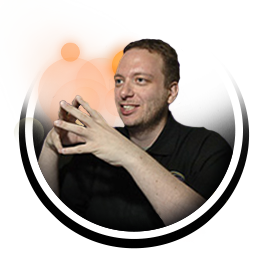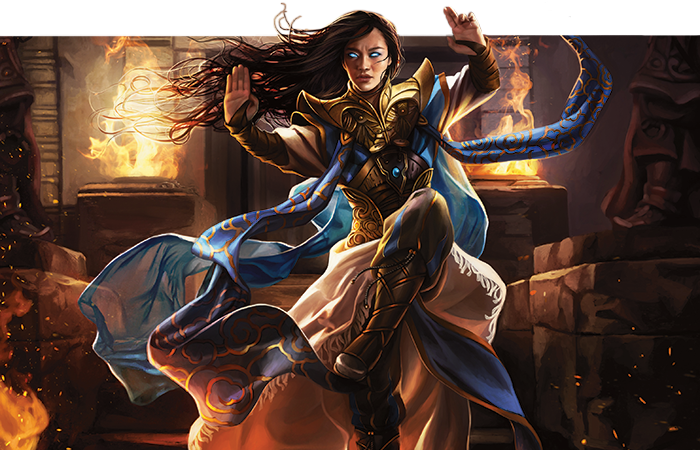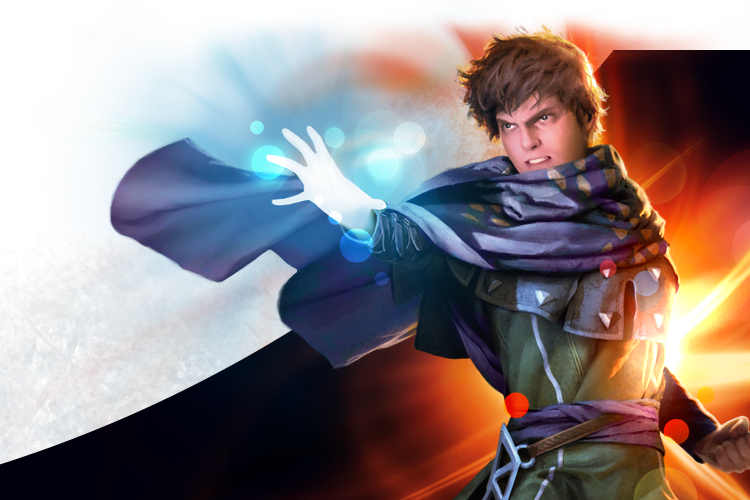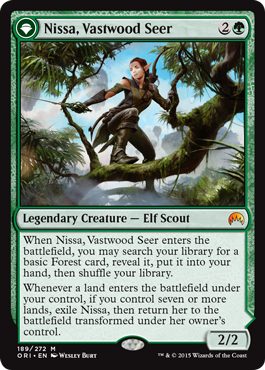The Species of Origins, Part 1
Welcome to the first Magic Origins Preview Week. On the surface, it might seem like just the last core set, but actually it's the beginning of a whole new era for Magic. This week and next I'm going to introduce you to the design team, walk you through the design, show off a couple new preview cards, and give you a peek behind the curtain of some of the cool things you can expect from Magic Origins. Let's get started.
The Origin-ators
I like to start my design articles by first introducing the people that did the design. So without further ado, let's meet the Magic Origins design team.
Shawn Main (lead)

There comes a time, metaphorically, when you have to toss the designer in a pool and hope that the swimming lessons have done their job. Magic Origins was Shawn's first time leading a large set. He had led Conspiracy but it was neither as big as Magic Origins nor as central to the game, being a Standard-legal set. To make matters much more complicated, the identity of the set was in constant flux and went through a major metamorphosis in the middle of design. (More on this below.) Through it all, Shawn proved that he had paid attention during all his swimming lessons and turned in an amazing design.
The first time I met Shawn was through the second Great Designer Search. He had made it past the first few tests and had gotten to the point where he had to submit his own world, along with some card designs to show off the kinds of things he would do with it. I knew from the first read-through that his word was improbable and would never stand up to the scrutiny of a real design, but I was fascinated by Shawn's passion and ingenuity. He kept finding clever and novel ways to distract from the gaping central flaw of his world design. Shawn managed to win two of the five competitions, which advanced him to the final three, and I remember thinking "Wow, if he can do this with an idea that can never work, imagine what he could do with one that could."
Flash forward to Magic Origins design. R&D had started a new process called advising, and I had the honor of being one of the first advisors. The set I was assigned was Magic Origins (because it was the only design team I wasn't on). The combination of this role along with my normal one as head designer one meant that Shawn and I had many lengthy talks about this set's design. I'm happy to say it's four years later and every gut instinct I had about Shawn has turned out to be true. He has grown into a strong designer that I am very happy to have on my team. Something you all will get to see with Magic Origins.
Mark Gottlieb

My relationship with Mark is a strange one. We went from archnemeses (when he was the rules manager and I was head designer—the rules manager is trying to do things the way they've always been done, and the head designer is trying to stretch into new territory) to co-conspirators when he became the manager for the design team. Mark both creates and solves puzzles in his spare time, which makes him very good at design as—at its core—it's a lot of puzzle solving. I'm glad Shawn had Mark on his team because if ever there was a set that needed puzzle-solving skills, this was it. (Once again, more on this in a moment.)
Ari Levitch

Ari was the creative team representative on the set. Normally, that's important. On this set it was vital, because this set was all about the creative. Shawn and his team had to figure out how to take a set that was about five different stories and make it into one cohesive whole. A big part of accomplishing the task was working very closely with Ari, because the execution of the creative wasn't additive but formative. It was a big task, but one Ari stepped up and performed wonderfully. As you get the chance to start looking through the set, don't just read the rules text. The art, the names, the flavor text are just as important to being able to appreciate what the set is about.
Nik Davidson

Nik is the equivalent of Erik Lauer and myself, but for the digital team in R&D. There are a lot of questions about how different digital offerings have to work and its Nik's job to have the big picture view. He was on this team because Magic Origins was integrally tied to Magic Duels (the new version of the product formerly known as Duels of the Planeswalkers). Magic Duels is an important part of the new evolution of Magic, and so it was vital that Nik be in the thick of things to make sure that everything was lining up between the two products. As with the rest of the team, Nik did an amazing job. (And by the way, if you haven't checked out Magic Duels, click here and learn all about it.)
Ian Duke

Ian was both the development representative on the design team as well as the overlap between the design and development teams. (We always have an overlap to make sure that there's someone on the development team able to speak up for the design vision.) Many of you might know Ian from his commentary on the Pro Tours. Ian is a pleasure to work with and does an amazing job of always asking the right questions. He has a wonderful insight and is able to aim the spotlight of discussion on the topics that most need it. I always enjoy having him on design teams and I know Shawn feels the same way.
The Secret Origins of Origins
When design for Magic Origins started, it was slated to be Magic 2016—just another core set. The last few core sets had been a little sluggish, so Shawn and his team were asked to try and come up with a fun twist for the set. The idea was they could give it a theme, something a little stronger than past core sets. They would then build their design around this theme and give the set a little more personality. So the design team did a lot of brainstorming. They talked with other teams, especially the creative team, and came up with what they thought was going to be a surefire hit…villains!
Magic has introduced a number of villain Planeswalkers over the years. We tend to focus more on the heroes and a little less on the villains, so what if we gave the evil Planeswalkers a chance to shine? What if, instead of the normal five Planeswalkers, there were in their place five villain Planeswalkers? And then the set could choose cards, themes, and a mechanic that all played up the theme of villainy. The design team liked the idea. The creative team liked the idea. Everyone else in R&D liked the idea…so it was a go.
For half of their design, Shawn and company were making the villain-themed core set. There were a few wrinkles. The Planeswalkers want to be color balanced and the villains tend to push toward certain colors and away from others. They toyed with the idea of having a cycle of two-colored Planeswalkers but realized that there wasn't a white-blue one, which they needed to finish their cycle. Venser, the only one we'd printed, had died and he wasn't even a villain. Khans of Tarkir block was talking about creating a white-blue Planeswalker (who would eventually become Narset). Perhaps that character could be a villain and then they could use her in the set. Other issues included how a mechanic felt villainous and what reprints best played into the theme.

Narset Transcendent | Art by Mageli Villeneuve
And then came the day when R&D realized we needed a big change. The big change would become the Two-Block Paradigm that I talked about last summer. Part of this change meant that the core set would be going away. As Tarkir block was too far along to shift, that meant that Magic 2016 would be the last core set. Okay, Shawn and his team were already trying to find a way to make it a little different, so they could also make it a big send-off for the core set.
But wait. Part of making the change was a fundamental shift in how many facets of the game were being handled. That included story. The villains theme was cute but it didn't play into the bigger plans that the creative team had for the story. Also, on the digital front, this change was going to alter how Duels of the Planeswalkers was going to work, changing it into Magic Duels. For this and other reasons, it became clear that the last core set was going to be as much a beginning as an ending. If Magic was going to go through a metamorphosis, this core set was going to be its premier. Shawn and his team were going to have to scrap everything and start over. Oh, did I mention, half of the time for design was already over?
A Fresh Start
Once it was clear the set was starting over, its theme came pretty quickly. If this set was the introduction to the new story, perhaps we needed to reintroduce the characters. The modern-style Planeswalkers have been around since Lorwyn. While we've seen them in many stories, we'd never spent much time talking about the history of any of them. A few novels touched upon it but that was all. In fact, of the five Planeswalkers chosen (Gideon, Jace, Liliana, Chandra, and Nissa), we only knew what world one of them was from. (Nissa was from Zendikar.) What if this set was about the origins of these five Planeswalkers?
Shawn and his team had a challenge. How do you make a design about five origin stories? The key to a strong design is having a singular cohesive vision, but the set wanted to tell five different stories. How was that possible?
The trick was realizing that the set wasn't telling five different stories but five versions of the same story. In each story, we meet our hero before they had become a Planeswalker. We see them on their home world and learn why each one of them has a problem. Things get bad and, in the moment of the negative feeling, their sparks ignite and they planeswalk for the first time. We then see them have an adventure on this new world, one thematically connected to the character, which ties into the problem introduced on their home plane.
That outline of the stories was the structure. Home plane ⇒ spark ignites, making them a Planeswalker ⇒ new plane. That meant that each story had two settings, pre- and post-ignition. We'd get to see each Planeswalker on their home plane and then on the plane of their first planeswalk. Also, the team would have to come up with a cool way to represent the moment of each character's spark igniting, making them a Planeswalker. In addition, the theme of the set would be about progression, about growing up, about becoming something.
With the idea of the ten world plan, Shawn made an important realization. Design and development worked hard to make sure there are ten different draft archetypes, usually centering around the two-color pairs. Ten worlds—ten two-color pairs. The themes of the draft archetypes could each be attached to a different world.
Shawn presented the idea of ten worlds—the five home planes and the five planes our characters first visited—to the creative team, who thought it fit perfectly with the stories they wanted to tell. They quickly figured out what those ten worlds were and then Shawn and his team started to flesh each out mechanically. (More on this next week.)
Spark Depths
Equally pressing was the challenge of figuring out how to represent the spark. You see, Planeswalkers aren't born with the ability to planeswalk. They are born with the potential to planeswalk. At some point during their life, during a time of great stress, their spark ignites, which is an involuntary planeswalk. This jumpstarts their ability to walk between worlds. Remember that up until that point, odds are they have no knowledge of the Multiverse. As far as they know, their world is the only world, so planeswalking for the first time is a scary and mind-blowing event.

Art by Chase Stone
The first thought was to have three cycles. First would be a legendary creature cycle representing each of the five characters before their spark ignites. Then we would have a second cycle of the same characters, but this time as Planeswalkers. This would represent them after their spark ignited. Finally, we would have a cycle of cards representing the moment their spark ignites. The first two cycles were pretty straightforward, but the spark cycle was a challenge. How exactly do you represent a spark? The team tried various designs but nothing was working.
And then came the crazy idea—what if the spark wasn't its own cycle. What if the spark was a transformation from one state, the legendary creature, into the second, the Planeswalker? Maybe there was something on the legendary creature that would allow you to search out the appropriate Planeswalker and swap with it on the battlefield? They took the idea one step further. What if the transformation was the transform mechanic and the two different cycles were on the same card—the legendary creature was on the front and the Planeswalker on the back?
Innistrad had already done double-faced cards, so it was clear that we could print them and that we could put them into booster packs without the players revolting. Shawn came to me one day. He explained that the team had come up with the perfect way to represent the spark. He walked me through the design. His concern—were double-faced cards an Innistrad thing or were they something we could do in another set if the design called for it? I said double-faced cards were a tool and that it was not limited to just one world.
"Did this idea warrant their use," Shawn asked.
"Absolutely," I said.
Interestingly, whenever anyone heard about the idea their first response was always "We have to do this." Everyone fell in love with the transforming Planeswalkers right away. The trick was figuring out how to make designs that stood up to the promise of the idea. The transformation had to be a quest, so the design team (and later the development team) worked hard to create little goals required to help each character "ignite their spark." They then made sure each creature had some way to help themselves toward that goal.
Since I owe you all a preview card and I'm talking about the transforming Planeswalkers, it seems only appropriate to show you one. After all, you need an example to see what I'm talking about, right? Okay, patient readers, let me introduce you to Nissa, Vastwood Seer, who will one day become Nissa, Sage Animist.


But Wait, There's More
Shawn and his team had one last big idea. If this was going to be the final core set, what if they made it a little bit more than a normal core set? What if it was a core set, plus? The idea they had was instead of bringing back a core-appropriate keyword mechanic, like the recent core sets had done, what if they created a new core-appropriate mechanic. And not just one, how about two. Shawn got permission and then set about making two new keywords.
There were a number of restrictions to keep in mind. The keywords had to be core-set appropriate, meaning they had to stay at or below a certain complexity level as well as be resonant. Also, they needed to play into the themes of the set—progression and growth. Probably one should go on creatures and the other on spells.
The design team also had to figure out how to structurally reinforce a set built around not mechanics but story. They had to show each Planeswalker pre and post spark ignition. They had to figure out how to convey not one story but five and to do so through mechanics, all while working closely with the creative team to make sure that all the cycles linking the structure of the five stories together was consistent.
Finally, they still had a normal core set to make which meant finding all the reprints that allowed the game play they wanted while also reinforcing the theme. This was made extra difficult by the restriction of not choosing cards whose art showed things that couldn't conceivably be on one of the ten worlds being supported.
Place of Origins
To recap, here's what was on the design team's plate:
- Figure out the ten two-color archetypes and match them to the ten worlds in the set
- Design five transforming Planeswalkers
- Create two brand new mechanics
- Create a mechanical framework to allow creative to tell five different stories
- Find appropriate reprints
- Make a fun core set
And all of this had to be done in half the time a normal core set got for design. Okay, go!
As always, I'm eager to hear any input on both today's column and what you've seen so far of Magic Origins. You can email me or talk to me through any of my social media (Twitter, Tumblr, Google+, and Instagram).
Join me next week, when I walk you through how the design team managed to pull it all off.
Until then, may you know the joy of transforming your creature into a Planeswalker.
"Drive to Work #236—Leading Teams"
In my twenty years, I have had the opportunity to lead a lot of teams. In this podcast, I talk about many of the things I've learned about how to do it best.
"Drive to Work #237—2010"
This is another in my series "20 Years in 20 Podcasts." In this podcast, I talk all about the year 2010.
- Episode 237 2010 (18.8 MB)
- Episode 236 Leading Teams (14.3 MB)
- Episode 235 Lessons Learned: Dark Ascension (17.8 MB)
- Episode 234 Lessons Learned: Innistrad (15.9 MB)
- Episode 233 Blue/Red (19.1 MB)
- Complete Drive To Work Podcast Archive

